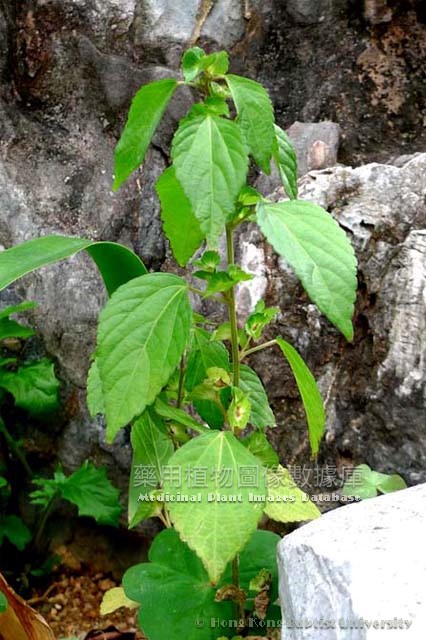|
|
|
Acalypha australis L.

|
English Name |
Acalypha, Copperleaf, Virginia Copperleaf |
|
Latin name |
Acalypha australis L. |
|
Family & Genus |
Euphorbiaceae, Acalypha |
|
Description |
Annual herbs, 30-50cm tall. Stem erect, branched, slightly pubescent. Leaves alternate; petioles 2-5cm; Leaves ovate-rhombus or ovate-oblong, 2-7.5cm long, 1.5-3.5cm wide, apex acuminate, base cuneate or round, base out 3 veins, margin with blunt serrate, coarsely on glabrous both sides. Spikes axillary, flowers unisexual, hermaphrodite; usually male inflorescences extremely short, 2-10mm long, borne in extremely small bracts; female inflorescences borne in leafy bracts; bracts reniform when unfolding, 1-2cm tall, clam-like when folding, margin with blunt serrate, base cordate; calyx four lobes; no petals; stamens 7-8; female flowers 3-5; ovary sparsely pubescent, 3-4-chambered; styles pinnately-lobated to base. Capsules small, triangular, semi-round, coarse hairs; seeds ovate, ca. 2mm, greyish brown. Flowering: May to July, fruiting: July to October. |
|
Distribution |
Growing in open fields, hills and moist roadsides. Distributed in the middle and lower reaches of the Yangtze River and Yellow River, Northeast, North, South and Southwest China, Taiwan. |
|
Part Used |
Medical part: whole plant. Chinese name: whole plant: Tiexian. |
|
Harvest & Processing |
Harvested in May–July, removed soil, sun-dried or used fresh. |
|
Chemistry |
Whole plant contains gallic acid, acalyphine, australisin, daucosterol and palmityl palmitate, etc. |
|
Pharmacology |
Antibiosis and pant-calming. |
|
Properties & Actions |
Bitter, harsh, cool.Clearing fever and damp, cooling blood and detoxifying and relieving distention. |
|
Indications & Usage |
Dysentery, diarrhea, hematemesis, non-traumatic hemorrhage, hematuria, hemafecia, metrorrhagia and metrostaxis, malnutritional stagnation in infants, furuncle and ulcer and skin eczema.Oral administration: decocting, 10-15g; Fresh products: 30-60g. External application: appropriate amount, or boiled in water, and wash, or applied in smashed pattern. |
|
Examples |
1. Infantile dyspeptic disease and diarrhea: acalypha 15g. Decoct in water for oral dose.
2. Bites by toxic snakes: acalypha, Chinese lobelia, mayflower glorybower, 30g each. Decoct in water for oral dose. |
|
Permanent URL:https://sys01.lib.hkbu.edu.hk/cmed/mpid/detail.php?herb_id=D00905 |
|
|
|

